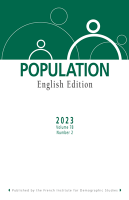
Population 2023 n° 2
2023
Surveying Public Opinion about Declining Birth Rates in France: The Enquête Natalité of 1942
Foreword
Antoine Prost
Testing Social Representations of Large Families and Childbearing: A 1942 Survey To Assess a Pronatalist Policy
Virginie De Luca Barrusse
The Carrel Foundation’s 1942 Survey on Declining Birth Rates: A Biopolitical Snapshot of France at a Demographic Turning Point
Fabrice Cahen, Paul-André Rosental
The Omission of Young Children in the French Census: What Can Linked Census Data Reveal?
John Tomkinson
Time Spent Without a Cohabiting Partner: An Analysis Across Cohorts in France
Nicolas Rebière, Nicolas Cauchi-Duval, Lyem Britah, Zoé Deloeil, Ines Munoz-Bertrand, Axel Redonnet, Margaux Tocqueville
School-Entry Cut-off Date and Birth Timing: No Evidence of Shifting in Spain
Manuel T. Valdés and Miguel Requena
Surveying Public Opinion about Declining Birth Rates in France: The Enquête Natalité of 1942
Foreword
Antoine Prost
Testing Social Representations of Large Families and Childbearing: A 1942 Survey To Assess a Pronatalist Policy
Virginie De Luca Barrusse
The survey on ‘the state of public opinion on declining birth rates’ conducted in 1942 by the French Foundation for the Study of Human Problems comprised a series of questions on collective beliefs and on attitudes to family policy. Its objective was twofold: to test social representations of large families and childbearing and to assess the scope for adjusting family policy in line with the Vichy regime’s objective to strengthen the pronatalist policy of the interwar period and to restore the prestige of large families. This article analyses 69 statements on these issues initially tested by a subgroup of interviewers. The survey sought to gauge public opinion about large families and to identify the beliefs that gave them a poor image. A second set of questions was designed to determine the acceptability of pronatalist policy.
The Carrel Foundation’s 1942 Survey on Declining Birth Rates: A Biopolitical Snapshot of France at a Demographic Turning Point
Fabrice Cahen, Paul-André Rosental
This article examines the creation of a 1942 survey designed to explore the causes of the declining birth rate in France and offer solutions, and revisits the data it produced. Led by the sociologist Jean Stoetzel, a pioneer of survey-based research, it consisted of a questionnaire developed with the interviewers themselves—mainly teachers and priests. The questions took up the themes of the pronatalist movement in all their diversity, from repressive proposals (including anti-abortion policies) to social measures for supporting households. The survey concluded that the French public supported natalism but believed that the causes of the low birth rate were primarily economic, rather than moral or religious. Financial incentives were deemed useful but insufficient. While Stoetzel recommended a propaganda campaign based on patriotism and moral reform, re-examination of the survey data shows that respondents were primarily concerned by the practicalities of the living conditions associated with large families. Within the range of moral attitudes expressed, repressive leanings were mainly concentrated in rural areas. Overall, survey respondents were sensitive to the plight of vulnerable populations, including single mothers.
The Omission of Young Children in the French Census: What Can Linked Census Data Reveal?
John Tomkinson
Census undercounts of young children, especially those aged under 5, persist worldwide. In the French census, an average of 1 in 20 young children have been missing from enumeration since annual census surveys were introduced in 2004. This study uses linked census data from the INSEE Permanent Demographic Sample to identify which children are omitted and from where, and offers possible explanations for why they are missing. The analysis finds that the specific omission of young children accounts for two-thirds of omissions; that the omission of young children is associated with their characteristics, especially those residing in complex households; and that internet enumeration has a positive impact on the enumeration of young children, reinforced by the recent redesign of the census household questionnaire.
Time Spent Without a Cohabiting Partner: An Analysis Across Cohorts in France
Nicolas Rebière, Nicolas Cauchi-Duval, Lyem Britah, Zoé Deloeil, Ines Munoz-Bertrand, Axel Redonnet, Margaux Tocqueville
While the share of people under age 65 without a cohabiting partner has been increasing in France since the late 1960s, the duration of these periods of solo living over the life course has never been studied. We calculate the aggregate length of time spent without a cohabiting partner for the cohorts born between 1926 and 1988 using data from the ERFI (2005) and EPIC (2013–2014) surveys, and use linear regressions to identify the factors behind the observed trends. These durations have evolved differently by gender and have shortened for women, who have benefited more than men from the decline in prolonged singlehood and early widowhood. For many years, social origin and educational level structured the length of time spent single, but their effects are progressively weakening. The first baby-boom cohorts (1945–1955) are an exception, having experienced the shortest periods without a cohabiting partner. The increasingly complex partnership trajectories of more recent cohorts thus correspond more to a shift in conjugal norms than to their rejection.
School-Entry Cut-off Date and Birth Timing: No Evidence of Shifting in Spain
Manuel T. Valdés and Miguel Requena
School-entry cut-off dates may incentivize parents to delay or hasten births due near the cut-off. Research has documented this behaviour in Asian countries, where educational competitiveness tends to be intense. Using an extensive database extracted from administrative registers, we analysed such birth shifting for Spain but found no evidence of this behaviour among Spanish parents. Our results hold even when stratifying the sample by mother’s educational attainment and country of birth. These findings not only confirm the distinction between European and Asian contexts; they also serve as a robust empirical ground for those works that assume randomness in births around the school-entry cut-off in regression discontinuity designs.

